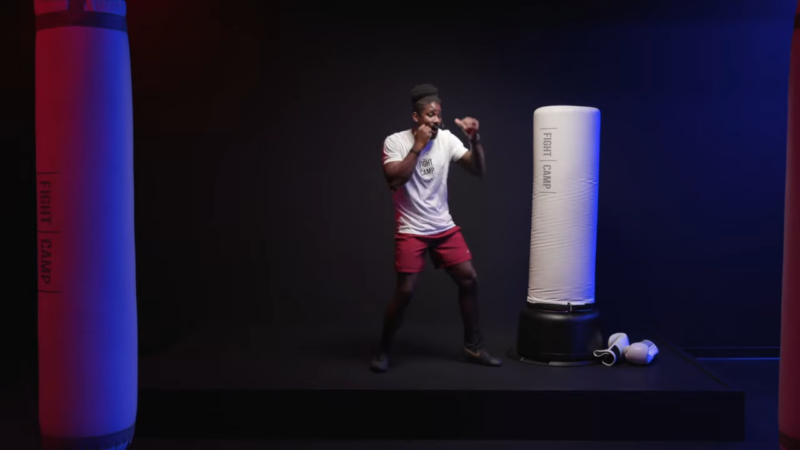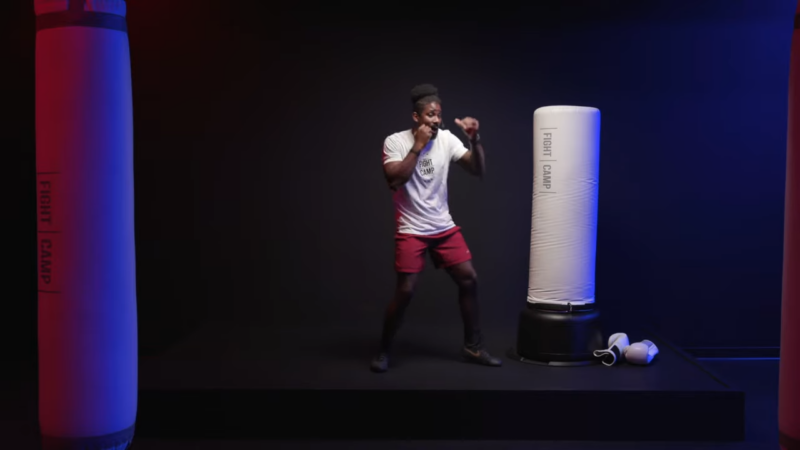Before we jump in, let’s talk about what shadow-boxing actually is. Essentially, shadow box is a form of solo practice where you simulate fighting an imaginary opponent. You throw punches, slips, and blocks into the air while moving around as if you’re in the ring.
It’s a key part of any boxer’s training routine, but it’s also a great workout for non-boxers looking to improve cardio, coordination, and technique.
Unlike hitting a bag or sparring with a partner, shadow-boxing focuses on form, movement, and flow. You’re building muscle memory and fine-tuning your skills without worrying about landing punches on an actual target.
Now that you’re sold on shadow box, let’s break down how to actually do it.
Step 1 – Prepare Yourself

Before you start throwing punches, there’s a bit of preparation needed. You don’t want to just dive right in, especially if you’re new to the practice.
Warm-Up
Just like with any physical activity, warming up is important to avoid injury. A light warm-up should get your heart rate up and loosen your muscles. A few ideas:
- Jump rope for 3-5 minutes
- Jog in place
- Do a few sets of jumping jacks or high knees
- Stretch your arms, shoulders, and legs
The goal is to feel warm and limber, so you can move smoothly as you box.
Find Space
You won’t need much space, but it’s essential to find an area where you can move around freely. Make sure there’s enough room to step forward, backward, and side to side without tripping over furniture or bumping into walls.
Get in the Right Mindset
Shadow box is as much about mental focus as it is physical movement. Visualize an opponent standing in front of you. Picture their movements, their attacks, and their counters. It’s important to mentally engage because that’s what keeps your movements sharp and intentional.
Step 2 – Master Your Stance
Your boxing stance is the foundation for everything. A solid stance gives you balance, stability, and the ability to move quickly in any direction.
How to Set Your Stance
- Stand with your feet shoulder-width apart
- If you’re right-handed, step your left foot forward (opposite if you’re left-handed)
- Keep your knees slightly bent
- Raise your hands to cheek height, elbows tucked in
- Your back heel should be slightly raised off the ground for quick movement
It might feel awkward at first, but this stance provides balance and mobility. You’ll need it as you throw punches and move around.
Step 3 – Basic Punches to Practice
There are four basic punches to focus on when shadow box: the jab, cross, hook, and uppercut. These are the building blocks of any boxing combo.
| Punch | Instructions |
| Jab | From your stance, extend your lead hand straight out. Snap it back quickly after the punch. Keep your other hand up by your face for defense. |
| Cross | Rotate your hips and shoulders as you throw your back hand straight toward your target. Pivot on your back foot for extra power. Snap your hand back to guard. |
| Hook | With your lead hand, throw a punch across your body in a curved motion. Keep your elbow bent at a 90-degree angle. Rotate your front foot and hips as you swing the punch. |
| Uppercut | Drop your lead hand down slightly and then punch upward in a scooping motion. Rotate your hips as you punch. Keep the punch tight and close to your body. |
Step 4 – Work on Footwork

Footwork is just as important as your punches. Shadow box allows you to practice moving while maintaining balance and control. The key is to stay light on your feet and move with purpose.
- Stay on the balls of your feet for quick movement
- Take small, controlled steps
- Move forward, backward, and side to side while keeping your stance intact
- Practice stepping forward as you jab, or pivoting to throw a hook
Good footwork helps you close distance when attacking and creates space when defending.
Step 5 – Putting It All Together
Now that you’ve got the basics down, it’s time to put everything together. Start by practicing simple punch combinations while moving around. Here are a few beginner combos to try:
| Combination | Description |
| Jab, Cross | Classic 1-2 punch. |
| Jab, Jab, Cross | Double up on the jab before delivering a powerful cross. |
| Jab, Cross, Hook | Add a lead hook after your 1-2 for a solid three-punch combo. |
| Jab, Cross, Uppercut | Throw an uppercut after your 1-2 for variety. |
As you practice, try incorporating movement. Step forward with your jab, pivot as you throw a hook, or step backward after a cross. The goal is to combine punches with footwork so you’re fluid and in control.
Step 6 – Focus on Defense

Shadow box isn’t just about offense. Defense is equally important in any real boxing match. While shadow boxing, imagine your opponent throwing punches at you, and practice your defensive moves.
- Slip: Bend your knees slightly and shift your head to one side to avoid a punch.
- Duck: Drop your knees and dip down to dodge punches.
- Block: Raise your arms to shield your face from an incoming punch.
- Roll: After slipping a punch, roll your body in a circular motion to evade the next punch.
Integrating defense into your shadow box helps build the habit of protecting yourself while staying active.
Breathing and Rhythm
Breathing is something many people overlook when they first start shadow box, but it’s crucial for stamina and performance. Exhale sharply each time you throw a punch. This keeps you from holding your breath, which can make you tire out more quickly.
Find a rhythm in your movement. Think of shadow-boxing like dancing—each step and punch should flow smoothly. Over time, you’ll develop your own style and rhythm that feels natural.
Shadow Box Rounds

Like in real boxing, shadow box is often done in rounds. Start with 2-3 minute rounds, followed by 30–60 seconds of rest. Aim for 3-5 rounds when you’re just starting out. During each round, vary your movements and punches. Mix up your combos, move around, and stay light on your feet.
*As you progress, you can add more rounds, increase your speed, or focus on specific skills like footwork or defense.
Tips for a Better Session
- Visualize a real opponent! Keep your imaginary opponent in mind the whole time. How are they moving? Where are they vulnerable?
- Stay loose. Don’t tense up. Relax your body, so your movements are fluid and natural.
- Keep your hands up. Always protect your face, even if you’re just punching the air.
- Mix it up! Avoid repeating the same moves over and over. Shadow box should be dynamic, so switch up your combos and movements.
Final Thoughts
Shadow box is an incredible tool for anyone looking to improve their boxing skills or just get a great workout. It might feel strange at first—throwing punches at nothing—but over time, it becomes an invaluable way to practice your technique, sharpen your mind, and develop a fighter’s instincts.




